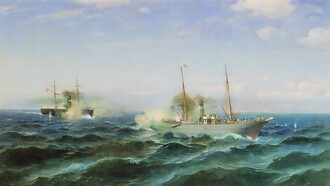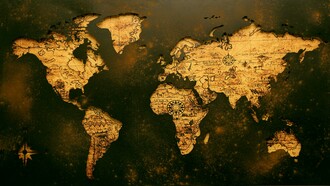Contrary to the general narrative, the Cold War did not end very peacefully. The Ukraine-Russia war is a continuation of a very uncivilized divorce that manifest itself in 1991-1994 in the aftermath of Soviet collapse. At that time, Moscow, under Boris Yeltsin, threatened the use of military force and preemptive strikes against the nuclear weapons of an independent Ukraine that were left over from Soviet collapse—if Kiev did not comply with Russian demands1.
The Russia-Ukraine divorce involved disputes over the division of Soviet assets, debts and currency, energy supplies, transfers and financing, as well as Russian claims to Crimea, plus control over territories in the Donbas and elsewhere in southeastern Ukraine. As the two sides divided their economic assets and military capabilities, Moscow was concerned with Kiev’s plans to build an independent army, navy and an air force—not to overlook Kiev’s possession of nuclear weapons.
At that time, in the effort to prevent the real possibility of war, the Clinton administration worked closely with Boris Yeltsin to pressure Kiev to sign both the NPT treaty and the START I treaty. Kiev had to agree to not only give up its enriched uranium left after Soviet break-up—but it also had to return its nuclear warheads to Moscow.
Russian pressures and threats, coupled with promises of U.S. aid and investment, eventually led Kiev to sign the 1994 Budapest memorandum that provided non-binding US, Russian and UK security assurances (not security guarantees)—in exchange for Kiev to give up its substantial former Soviet nuclear weaponry.
This was a major diplomatic accomplishment for the Clinton administration. At the same time, Moscow was not fully satisfied. Moscow’s dissatisfaction with U.S. policy was revealed when the ‘pro-American’ Boris Yeltsin exploded in rage in December 1994—just after signing the Budapest memorandum.
Yeltsin was angered by the fact that Washington was beginning to push the enlargement of NATO’s nuclear alliance into former Soviet spheres of influence and security faster than the Clinton administration had admitted to him. In effect, just after Moscow had blocked Ukraine from retaining an independent nuclear capability through the Budapest accord, Washington was already proposing the expansion of NATO’s nuclear alliance into former Soviet spheres of influence and security!
Much as Washington was adamantly determined not to permit Moscow deploy nuclear weapons in Cuba, there was no way Moscow would permit Kiev—or potentially NATO—to point nuclear weaponry into the soft underbelly of the Russian heartland. Yeltsin’s outrage in 1994 forewarned Putin’s revenge in 2022.
The 2008 Bucharest NATO Summit
The real possibility of conflict between Kiev and Moscow in 1991-94, plus the high costs of trying to sustain a nuclear deterrent by a largely bankrupt and instable Ukraine that was still haunted by the Chernobyl nuclear power plant disaster, reveals the absurdity of neo-realist claims that Kiev could have, and should have, retained its nuclear weapons capabilities.
Yeltsin’s outburst in late 1994 also foreshadowed how Putin would react to NATO enlargement closer to Russian borders—particularly after the 2008 Bucharest NATO summit. Much like Yeltsin’s outburst against NATO expansion in 1994, Putin gave a highly critical speech at the Munich Security Conference in 2007 that warned against U.S., European and NATO policies in the years after NATO’s air war over Kosovo in 1999 that accompanied NATO expansion.
At the 2008 NATO Bucharest summit, NATO formally promised, against Russian red lines, that Ukraine (and Georgia) could eventually join NATO—a promise that was seen by Moscow as an indirect violation of the 1994 Budapest accord in that it would link Ukraine to a “nuclear alliance” as NATO likes to call itself.
As U.S. and Russian relations continued to deteriorate, the key issue is why Washington continued to provoke Moscow’s elites (and not just Putin) in the period 2008-2022 with the official promise that Georgia and Ukraine could eventually join NATO. This was true even though American elites, including then Ambassador to Russia, William Burns, who is presently President Biden’s CIA director, were well aware that the promise of NATO membership for Kiev could result in a Russian military intervention in Ukraine.
Questions also remain as to why Washington continued to promise NATO membership for Ukraine when many NATO members, including France and Germany, were opposed, and even though the U.S. itself realized that Kiev would not be able to join NATO in the foreseeable future.
France, for example, proposed the option of formally establishing Ukraine as a “neutral” country, but the U.S. remained opposed and refused to engage in full-fledged discussion to formulate new European Security Treaty as proposed by Moscow in 2008-09 and later again by Paris.
As I have warned at least since 1994,2 any effort to move Ukraine away from a relatively neutral position between the US, Europeans, and Russia by bringing Ukraine into the Russian-led CSTO or by offering it NATO membership, or else by permitting Kiev to retain an independent nuclear weapons capability, would upset the new post-Cold War European and global equilibrium—at the risk of major power war.3
After the Russian invasion
On August 23, 2021, Kiev launched its “Crimean platform” to obtain international assistance for the return and de-occupation of Crimea, after the U.S., EU, G-7, Turkish, as well as NATO, had all stated that they would never recognize Moscow’s annexation of Crimea. (In geopolitics one should never say never!)
Kiev’s initiative led Moscow to question what kind of finance and defense supports would NATO and non-NATO countries provide Kiev in the effort to press Moscow to return Crimea back to Ukraine—whether by peaceful means or not.
Kiev’s Crimea Platform was then followed by the signing of the U.S.-Ukraine Charter on Strategic Partnership on November 10, 2021. In that Charter, the Biden administration reaffirmed its support for “Ukraine’s right to decide its own future foreign policy course free from outside interference, including with respect to Ukraine’s aspirations to join NATO.” From Moscow’s perspective, this was a declaration of war.
At the Munich Security Conference in February 2022, a few days before the Russian invasion of Ukraine, Ukrainian president Volodymyr Zelensky complained that Kiev had not yet obtained adequate security guarantees from the 1994 Budapest accords, from NATO, or from nuclear weapons. Such security accords, he argued, would have deterred Putin from annexing Crimea and interfering in the Donbas region. His statement implied that Kiev wanted some form of nuclear protection as soon as possible—once again enraging Moscow.
On the eve of Russia’s invasion, border clashes in the Donbas mounted in intensity given Kiev’s apparent unwillingness, in Moscow’s perspective, to settle the Donbas dispute by permitting greater autonomy for Donetsk and Luhansk in accord with the Minsk II accords. The fact of the matter is that the dispute festered since 2014 in large part because Washington did not strongly back French and German efforts to resolve the Donbas question.
Putin then invaded Ukraine in February 2022 in a criminal act of preclusive imperialism. Putin’s aim was to check the possibility of NATO enlargement, while brutally preventing Kiev from ever threatening Russian interests—much as the U.S. sought to totally eliminate Saddam Hussein’s nuclear capabilities in 2003, whether or not he possessed such capabilities at the time.
In addition to the nuclear question, Putin justified his “special humanitarian operation” on much the same grounds as NATO had justified its intervention in Libya in 2011, by claiming that the Ukrainians were committing “genocide” in the Donbas. In both the Libyan and Ukrainian cases, NATO and Russian claims to “genocide” were highly exaggerated.
U.S. and European strategic options
The U.S. and Europeans are still divided as to how much military force they should provide Kiev in the effort to drive Russian troops out of the country. One of the proposed measures is to implement a “no fly zone” over Ukraine. An even more hardline approach is to engage in a nuclear “showdown”—or what I have called “Brinkman&Womanship”—that is intended to force Moscow to remove its forces from Ukraine upon the threat of nuclear war. These options risk direct US-NATO-European-Russian confrontation and nuclear Armageddon.
A third option is a protracted proxy war in support of the Ukrainian resistance versus Putin’s invasion. This option appears designed to further weaken Russia, while indirectly seeking to check Beijing from tightening its alliance with Moscow. Preventing Beijing and Moscow from moving closer together is to be accomplished by threatening additional U.S. sanctions on China if Beijing opts to support Moscow militarily, if not economically. In response, Beijing appears to be strengthening its political economic ties with Asian powers, as well as the Middle East and North African states—so as to better counter U.S. pressures.
Risks of protracted proxy war
On the surface, the third option of a protracted proxy war appears less risky than the previous two options. Nevertheless, such an approach could soon widen the conflict—if Putin (or Washington) opts to open new fronts of conflict.
On the one hand, the apparent Russian retreat from Kiev and other northern regions has galvanized the Ukrainian resistance to fight even harder. Concurrently, Kiev has been attempting to shame the U.S. and Europeans by charges of “appeasement”—for not providing greater military assistance, particularly in the aftermath of recent revelations of alleged Russian atrocities in Bucha and elsewhere. Kiev has been warning the U.S. and Europeans that the failure to stop Putin now will purportedly provide him with a greenlight to expand further into Europe or elsewhere in the near future.
Contrary to the views of hardliners, however, Putin’s goals presently appear to be more like those of Bismarck or Lenin than those more extensive goals of Wilhelm II, Hitler or Stalin. Putin’s inability to achieve regime change by seizing Kiev, coupled with Russian losses on the battlefield, appears to have forced him to limit his goals to eastern Ukraine.
Now Putin apparently wants to expand Russian control beyond Donetsk and Luhansk, possibly to Kharkiv. In calling up the reserves and by drafting more manpower, and by devastating the port of Mariupol, guarded in part by the neo-Nazi Azov Brigade, Putin may want to establish a land bridge to southern Ukraine that could provide a water supply for the Crimean isthmus.
Putin’s response to sanctions
On the one hand, the fact that stronger U.S. and European sanctions on Russia will weaken, if not destabilize, Russian society in the not-so-long term could possibly press Putin to seek peace—as Washington wants to believe. On the other hand, stronger sanctions, plus U.S. promises to provide Kiev more sophisticated weaponry, could also lead Putin to further intensify and expand his war efforts—if there is no peace settlement in Ukraine in the near future.
In the hope that sanctions will backfire and help to cause significant price increases throughout the world due to supply shortages of energy, raw materials, rare earth minerals, grain and agricultural products, Putin could then try to manipulate social discontent and fuel social and political conflicts abroad—in Europe and elsewhere.
Instead of directly attacking NATO member countries—as this would be of dubious interest to Moscow at this time—Putin could try to divert U.S. and European attention from Ukraine by seeking to destabilize Moldova or Georgia. Moscow could move to more strongly back Tehran’s goals in the wider Middle East—particularly if the Iran nuclear accord collapses without sustaining Russian interests.
Putin could also return to the playbook of the early Cold War when Russia and China had just forged their alliance in 1950. While Stalin had then threatened Tito in Yugoslavia at the start of the Korean War, Putin could somewhat similarly provide stronger support to Serbian pan-nationalists and to Bosnian and Kosovar Serbs—if no progress can soon be made to defuse Balkan disputes.
And somewhat like Stalin and Mao, if Xi Jinping would eventually agree, Putin could work to re-flame tensions on the Korean peninsula, or continue to pressure the northern territories/Kurile islands against Japan, or even more strongly support China’s demands to annex Taiwan.
The nuclear option?
Germany is being heavily criticized for becoming too dependent on Russian gas when Berlin definitely should have invested more funding into alternative green energies. At the same time, the American shale gas producers are standing by to profit by selling gas to Europe once and if the Russian gas flow to Europe drops to a trickle—providing fuel for yet another conspiracy theory.
The dilemma is this: What if cutting off German and European gas and energy imports from Russia—as Europe is much more dependent on Russian energy than is the U.S.—is eventually considered an “existential threat” for Putin, his oligarch cronies, and the Russian people in general? Will Putin then choose the nuclear option in accord with Russia’s strategic doctrine?
Or could he use tactical nuclear weapons against Ukrainian forces if he cannot obtain his goals in the near future? It has been said that he needs to declare some form of “victory” by the time of the May 9th 2022 celebration of the Soviet defeat of Nazi Germany.
Yet rather than use nuclear weaponry as has been threatened by Putin’s official spokesperson, however, or else risk directly attacking NATO or non-NATO members, such as Sweden, that have begun to upgrade arms deliveries to Ukraine as “co-belligerents,” as hardliners fear, Putin has other options. He could instead engage in major acts of cyber warfare by attacking critical U.S. and European infrastructure, while also deploying more nuclear weapons in the Baltic region against Finnish and Swedish efforts to join NATO. He could also secretly finance possible terrorist attacks against U.S. and European interests through proxy groups.
Then again, having drawn redlines with respect to the threat to use nuclear weaponry, it could prove difficult for Putin to back track on those threats without losing face—unless a viable diplomatic alternative can soon be formulated.
Toward engaged diplomacy
U.S. and European support for protracted war is a dangerous policy that risks expanding the conflict beyond Ukraine. In accord with the dialectics of security and insecurity, the longer the war, the greater the devastation for Ukraine, the greater the risk that world-wide domestic socio-economic disputes and interstate geopolitical conflicts could draw more and more societies and states into the fray while overlooking the need to resolve other ongoing disputes and wars.
The realization that China will benefit most from the conflict over Ukraine should lead Washington, the Europeans and Moscow to come to their senses and put an end to this conflict as soon as possible. Putin now appears to be handing his country over to Beijing on a silver bowl filled with natural gas, aluminum, steel and “rare earth” resources—plus arms so that Beijing can pursue its irredentist claims to Taiwan if it so chooses. And even assuming the conflict in Ukraine soon comes to an end, China will be able to profit from a sanctioned and isolated Russia.
All this is to say that the Biden administration and the Europeans should begin to engage in real diplomacy as soon as possible. Even as the war rages on, the Zelensky government has proposed a “neutrality” accord with some form of international security guarantees that will need to be discussed and refined, plus a 15-year period of negotiations over what to do separately about Crimea, while also proposing that the status of Donetsk and Luhansk be discussed directly with Putin.
In this regard, the deployment of international peacekeeping forces in disputed areas of Ukraine under OSCE or UN auspices could provide concrete security guarantees that the 1994 Budapest accords did not provide.4 International forces could also assist the vital need to reconstruct the entire society with the aid and assistance of the European Union, China, the U.S., among other states—in the context of a new European Security treaty that could ultimately be forged by the US, EU, and Russia—that is, once, and if, the dust settles.
How Moscow will respond to such diplomatic efforts remains to be seen. At present, Putin says talks are at a dead end, while Kiev argues they are difficult, but still ongoing. In any case, it is crucial that the Biden Administration more strongly back French, Israeli, and Turkish diplomatic initiatives, if not those of China, in order to press Ukraine and Russia to mend their differences—in an effort to achieve a modicum of peace before everything goes to Hell.
Notes
1 Hall Gardner, Surviving the Millennium: American Global Strategy, the Collapse of the Soviet Empire and the Question of Peace (Westport, CT: Praeger, 1994).
2 Hall Gardner, Surviving the Millennium: American Global Strategy, the Collapse of the Soviet Empire and the Question of Peace (Westport, CT: Praeger, 1994).
3 As I put it in 2005, “Unless both Russia and Ukraine can both be drawn into NATO and a strengthened EU, in new forms of membership, maintaining Ukrainian neutrality between NATO and Russia appears key to maintaining the new post-Cold War equipoise.” Hall Gardner, American Global Strategy and the War on Terrorism (London: Ashgate, 2005).
4 See Hall Gardner, Crimea, Global Rivalry and the Vengeance of History (New York: Palgrave/Macmillan, 2015).















